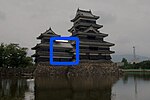使用者:JuneAugust/test1
外觀
| 姓名 | 城堡 | 結構 | 日期 | 位置 | 圖片 |
|---|---|---|---|---|---|
| 天守(天守)[nb 1][1] | 彥根城 | donjon,3重3階,外加一個地下室和入口,本瓦葺頂[ex 1] | 安土桃山時代,1606年 | 滋賀縣彥根市 | 
|
| 望樓(附櫓)和多聞櫓(多聞櫓)[nb 1][3] | 彥根城 | yaguras, each single-storied, hongawarabuki roof[ex 1] | 安土桃山時代,1606年 | 滋賀縣彥根市 | 
|
| 大天守閣(大天守)[4] | 姬路城 | 安土桃山時代,1608年[5] | 兵庫縣姬路市 | 
| |
| 乾小天守(乾小天守)[6] | 姬路城 | donjon,本瓦葺頂[ex 1],3重4階外加地下1層[7]。最上面一階有火燈窗[8],東接呂之渡櫓,南接波之渡櫓[nb 2],位於大天守閣的對角,比其他兩座小天守閣略大[8]。以拆除豐城秀吉原本修建的上一代三層天守後的材料移建而成[9][10]。 | 安土桃山時代,1609年左右[10] | 兵庫縣姬路市 | 
|
| 西小天守閣(西小天守)[11] | 姬路城 | donjon,本瓦葺頂[ex 1],3重3階外加地下2層[7]。 最上面一階有火燈窗[12],東接二之渡櫓,北接波之渡櫓[nb 3]。 | 安土桃山時代,1609年左右[13] | 兵庫縣姬路市 | 
|
| 東小天守(東小天守)[14] | 姬路城 | donjon,本瓦葺頂[ex 1],3重3階外加地下1層[7]。 內部裝飾較為樸素[13]。西接呂之渡櫓,南接伊之渡櫓[nb 4]。 | 安土桃山時代,1609年左右[13] | 兵庫縣姬路市 | 
|
| 伊、呂、波、二之渡櫓(イ, ロ, ハ, ニの渡櫓)[nb 5][nb 6][15] | 姬路城 | 2重2階,外加1層地下室,本瓦葺頂[ex 1]
伊之渡櫓:在大天守與東小天守之間,高9.03公尺(29.6英尺), 建在8.88米(29.1英尺) 高的石垣上。 呂之渡櫓:在東小天守和乾小天守之間,高9.03公尺(29.6英尺),建在8.3米(27英尺)高的石垣上。 波之渡櫓:在乾小天守和西小天守之間,高9.17公尺(30.1英尺),建在10.06米(33.0英尺) 高的石垣上。 二之渡櫓:在西小天守和大天守之間,高9.68公尺(31.8英尺),占地面積56.78平方公尺(611.2平方英尺)。下有可供進入4座天守包圍的中庭的「水之五門」[16]。 |
安土桃山時代,1609年左右 | 兵庫縣姬路市 | 
|
| 天守閣(天守)[17] | 犬山城 | 安土桃山時代,1601年 | 愛知縣犬山市35°23′18″N 136°56′21″E / 35.38833°N 136.93917°E | 
| |
| 天守閣(天守)[nb 7][18][19] | 松江城 | donjon, four stories/five floors with an underground room, hongawarabuki roof[ex 1] | 安土桃山時代,1607–1611年 | 鳥根縣松江市 | 
|
| 附櫓(附櫓)[nb 7][18][19] | 松江城 | yagura,1重1階,本瓦葺頂[ex 1] | 安土桃山時代,1607–1611年 | 鳥根縣松江市 | 
|
| 天守閣(天守)[nb 8] | 松本城 | main donjon,本瓦葺頂[ex 1],5重6階[20]。帶有望樓型要素的層塔型天守[21]。在第4階設有「御座之間」[22]。 | 安土桃山時代,文祿年間[23] | 長野縣松本市 | 
|
| 乾小天守(乾小天守)[nb 9] | 松本城 | secondary donjon,本瓦葺頂[ex 1],3層4階,因位於大天守的乾方位(西北)而得名[24]。 | 安土桃山時代,文祿年間 | 長野縣松本市 | 
|
| 渡櫓(渡櫓)[nb 9] | 松本城 | yagura,2重2階,本瓦葺頂[ex 1] | 安土桃山時代,文祿年間 | 長野縣松本市 | 
|
| 辰巳附櫓(辰巳附櫓)[nb 9] | 松本城 | yagura,2重2階,本瓦葺頂[ex 1],連接大天守和月見櫓[25],因位於大天守的辰巳方位(東南)而得名[24]。 | 江戶時代早期,寬永年間[26] | 長野縣松本市 | 
|
| 月見櫓(月見櫓)[nb 9] | 松本城 | yagura,本瓦葺頂[ex 1],寄棟式頂[25],原本是為接待將軍到訪的御成[a]而修建[26],天花板為船底天井[b],房間的三面裝有可拆卸的舞良戶[c],沒有狹間[25] | 江戶時代早期,寬永年間[26] | 長野縣松本市 | 
|
- ^ 1.0 1.1 The National Treasure structures of Hikone Castle are registered as a single National Treasure under one registration number. Only in the main treasure table of this article, the single entry is split in two parts for readability.
- ^ The four corridors at Himeji Castle are labeled as "I", "Ro", "Ha", "Ni" corresponding to "A", "B", "C", "D".
- ^ The four corridors at Himeji Castle are labeled as "I", "Ro", "Ha", "Ni" corresponding to "A", "B", "C", "D".
- ^ The four corridors at Himeji Castle are labeled as "I", "Ro", "Ha", "Ni" corresponding to "A", "B", "C", "D".
- ^ The four corridors at Himeji Castle are labeled as "I", "Ro", "Ha", "Ni" corresponding to "A", "B", "C", "D".
- ^ The kitchen is attached to the nomination.
- ^ 7.0 7.1 The National Treasure structures of Matsue Castle are registered as a single National Treasure under one registration number. Only in the main treasure table of this article, the single entry is split in two parts for readability.
- ^ The National Treasure structures of Matsumoto Castle are registered as a single National Treasure under one registration number. Only in the main treasure table of this article, the single entry is split in five parts for readability.
- ^ 9.0 9.1 9.2 9.3 The National Treasure structures of Matsumoto Castle are registered as a single National Treasure under one registration number. Only in the main treasure table of this article, the single entry is split in five parts for readability.
- ^ Hikone Castle. jcastle.info. [2017-12-17]. (原始內容存檔於2017-12-16).
- ^ hongawarabuki. JAANUS – Japanese Architecture and Art Net User System. [2009-11-09].
- ^ Hikone Castle. jcastle.info. [2017-12-17]. (原始內容存檔於2017-12-16).
- ^ 姫路城大天守. Himeji city. [2009-11-17]. (原始內容存檔於2016-06-24) (日語).
- ^ 日本名城解剖書,第10頁
- ^ 姫路城乾小天守. Himeji city. [2009-11-17] (日語).
- ^ 7.0 7.1 7.2 引用錯誤:沒有為名為
日本名城解剖书p59的參考文獻提供內容 - ^ 8.0 8.1 日本名城解剖書,第10頁
- ^ 戰國日本1 時間的滋味,第243-244頁
- ^ 10.0 10.1 日本名城解剖書,第10頁
- ^ 姫路城西小天守. Himeji city. [2009-11-17]. (原始內容存檔於2016-06-24) (日語).
- ^ 日本名城解剖書,第10頁
- ^ 13.0 13.1 13.2 日本名城解剖書,第10頁
- ^ 姫路城東小天守. Himeji city. [2009-11-17]. (原始內容存檔於2016-06-24) (日語).
- ^ 姫路城イ・ロ・ハ・ニの渡櫓附台所1棟. Himeji city. [2009-11-17]. (原始內容存檔於2016-05-08) (日語).
- ^ 日本名城解剖書,第56頁
- ^ Inuyama Castle. Japanese National Tourism Organization. [2011-08-29].
- ^ 18.0 18.1 Matsue Castle. jcastle.info. [2017-12-17]. (原始內容存檔於2017-12-16).
- ^ 19.0 19.1 松江城天守の国宝指定について. Matsue city. [2015-09-21] (日語).
- ^ 日本名所解剖書,第126頁
- ^ 日本名所解剖書,第127頁
- ^ 日本名城解剖書,第64頁
- ^ 戰國日本 1 時間的滋味,第250頁
- ^ 24.0 24.1 日本名所解剖書,第126頁
- ^ 25.0 25.1 25.2 日本名城解剖書,第64頁
- ^ 26.0 26.1 26.2 日本名城解剖書,第62頁
- ^ 引用錯誤:沒有為名為
日本名城解剖书p62的參考文獻提供內容 - ^ 28.0 28.1 引用錯誤:沒有為名為
日本名城解剖书p64的參考文獻提供內容
引用錯誤:頁面中存在<ref group="ex">標籤,但沒有找到相應的<references group="ex" />標籤
引用錯誤:頁面中存在<ref group="lower-alpha">標籤或{{efn}}模板,但沒有找到相應的<references group="lower-alpha" />標籤或{{notelist}}模板

